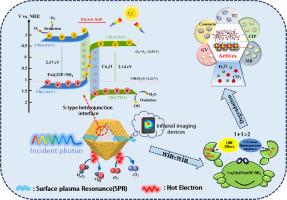Full-spectrum efficient photocatalytic pollutant degradation via Cu-N bridged S-type heterojunctions interface and LME effect by single-Fe-atoms
IF 6.3
2区 材料科学
Q2 CHEMISTRY, PHYSICAL
引用次数: 0
Abstract
Effective separation and utilization of photogenerated charges are pivotal for enhancing the photocatalytic process. In this study, we designed an atomic-level interface chemical bond (Cu-N bond) and successfully synthesized a novel Cu2O(x)/Fe@ZIF-NH2 S-Scheme heterojunction. The Fe@ZIF-NH2 component was constructed by embedding abundant isolated Fe sites and amine groups within a Zn-MOF (ZIF-8) matrix. Under full solar-spectrum illumination, the Cu-N interface bridge, the local microenvironment (LME) engineered by isolated Fe atoms, and the modulation of the internal electric field synergistically promote directional charge migration. The optimized Cu2O(4)/Fe@ZIF-NH2 achieves a superior tetracycline (TC) degradation rate constant of 0.0042 min−1, representing 7-fold and 10.5-fold improvements over pristine Cu2O and ZIF-8, respectively. Notably, photo-thermal conversion is observed, with the synergistic action of photocatalysis and thermal activation enabling the removal of 98% of TC and over 85% of other pollutants, including ciprofloxacin, coumarin, gentian violet, and methylene blue. Comprehensive characterization confirms the photo-thermal contribution, revealing that Cu2O acts as a “nano-heater,” while the LME surrounding single Fe atoms accelerates surface reaction kinetics. Mechanistic insights derived from radical trapping experiments, photoelectrochemical tests, and in situ XPS analysis elucidate cooperative charge transfer pathways. This study presents a promising strategy for designing high-performance photocatalysts through interfacial engineering and single-atom modulation for advanced water purification applications.

基于Cu-N桥接s型异质结界面和单铁原子LME效应的全光谱高效光催化污染物降解
有效分离和利用光生电荷是提高光催化性能的关键。在这项研究中,我们设计了一个原子级界面化学键(Cu-N键),并成功合成了一个新的Cu2O(x)/Fe@ZIF-NH2 S-Scheme异质结。Fe@ZIF-NH2组分是通过在Zn-MOF (ZIF-8)基质中嵌入大量分离的Fe位点和胺基而构建的。在全太阳光谱照明下,Cu-N界面桥、孤立铁原子设计的局部微环境(LME)和内部电场的调制协同促进定向电荷迁移。优化后的Cu2O(4)/Fe@ZIF-NH2对四环素(TC)的降解速率常数为0.0042 min−1,分别比原始Cu2O和ZIF-8提高了7倍和10.5倍。值得注意的是,光热转化被观察到,光催化和热活化的协同作用使98%的TC和85%以上的其他污染物,包括环丙沙星、香豆素、龙胆紫和亚甲基蓝被去除。综合表征证实了光热的贡献,揭示了Cu2O作为“纳米加热器”的作用,而围绕单个铁原子的LME加速了表面反应动力学。来自自由基捕获实验、光电化学测试和原位XPS分析的机制见解阐明了合作电荷转移途径。本研究提出了一种通过界面工程和单原子调制设计高性能光催化剂用于高级水净化应用的有前途的策略。
本文章由计算机程序翻译,如有差异,请以英文原文为准。
求助全文
约1分钟内获得全文
求助全文
来源期刊

Surfaces and Interfaces
Chemistry-General Chemistry
CiteScore
8.50
自引率
6.50%
发文量
753
审稿时长
35 days
期刊介绍:
The aim of the journal is to provide a respectful outlet for ''sound science'' papers in all research areas on surfaces and interfaces. We define sound science papers as papers that describe new and well-executed research, but that do not necessarily provide brand new insights or are merely a description of research results.
Surfaces and Interfaces publishes research papers in all fields of surface science which may not always find the right home on first submission to our Elsevier sister journals (Applied Surface, Surface and Coatings Technology, Thin Solid Films)
 求助内容:
求助内容: 应助结果提醒方式:
应助结果提醒方式:


